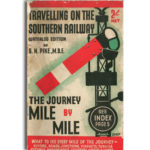Description
Sir Herbert Walker, the extremely talented General Manager of the Southern, appointed two men who between them, would fashion the public face of the Company for much of its existence. John Elliot, a young journalist with excellent Fleet Street and political connections became the first executive in Britain to carry the job title “PUBLIC RELATIONS OFFICER”. The other was Cuthbert Grasemann, Advertising Manager, whose fath commissioned work from both established and rising journalists, writers and artists, to present the Southern to the public in the most favourable light, and even more important, to get people to travel by train.
Grasemann himself was particularly interested in the shipping services and wrote or co-authored two books on the subject, although neither was published by the Southern, he would have needed permission from the General Manager to write about Southern matters for another publisher.
“The Atlantic Coast Express” written by S.P.B. Mais and published in 1937, contains a description of the routes followed by this famoustrain, with line drawing illustrations by Anna Zinkeisen throughout and a fold out map with black and white photos at the back of the book. Unfortunately, two or three of these have been “harvested” by a scrap book enthusiast from our copies… Stuart Petre Brodie “SPB” Mais (1885–1975) was a prolific British author, journalist and broadcaster, who is credited with having written over 200 books, many of which concerned the English countryside. His forte was of the “Hiking in Hertfordshire,” “Rambles in Epping Forest” genre, many of which were commissioned by railway companies to encourage day trip travel. Apparently throughout his life only a few steps ahead of creditors for some reason, his daughter recalled on one occasion, having to surrender the contents of her Piggy Bank to bailiffs armed with County Court Orders. Mais undertook work for other railways, including the LMS.
Anna Katrina Zinkeisen (1901 – 1976) was a Scottish born painter and illustrator, specialising in portraits, magazine covers and murals. With her better – known elder sister, Doris, she was commissioned to paint murals in both the “Queen Mary” and the “Queen Elizabeth” Cunard White Star liners. Doris painted numerous railway posters, and it may have been through this connection that Anna obtained the commission for “ACE”. Personally, I find her drawings rather whimsical and twee, and printing them in very pale blue and red ink does not help in quickly identifying the subject. It is more perhaps of a souvenir to read at home as a holiday memory, than of practical use at 60 mph!
John Elliot proposed to the board in 1925 that the next batch of new express passenger locomotives be named after characters fromArthurian legend, (Chief Mechanical Engineer Richard Maunsell rather grudgingly agreed, but pointed out that names would not make the locomotives go faster!) Elliot also proposed that a named train be introduced, vying for attention with the Great Western Railway “Cornish Riviera Express”. The name Atlantic Coast Express” was chosen as the result of a competition run in the staff magazine and the winning entry was submitted by Mr F. Rowland, a guard stationed at Woking who won a prize of three guineas. The train made its inaugural run on 19 July 1926. The heavy reliance on holiday passengers meant that the volume of traffic was very seasonal. On Summer Saturdays, the ACE consisted of up to five trains departing from Waterloo in the 40 minutes before 11:00, stretching resources on the long single-track branch lines in the west to the limit. In the winter timetable, one train was sufficient for all of the branches, and stops were made at all but the most insignificant stations west of Exeter. Significant delays were frequent at the junctions, as coaches were detached or attached and shunted between the various sections of the train, belying the name of “Express”.
In later years, a carriage was detached at Salisburyto join a following stopping train along the main line, and two carriages were detached at Sidmouth Junction, one for Sidmouth and one for Exmouth Bude (10:54) and a final departure at 11.00 with portions for Padstow, Bude and Plymouth. Services continued in much the same pattern until the outbreak of WW II, which necessitated longer trains and substantial deceleration on all lines, rendering named trains no longer appropriate.
The 1950s marked the highpoint of the reinstated ACE, with the first mile-a-minute timing on the Southern Region (as the Southern Railway had become) with a 12:23 arrival in Salisbury, 83 miles from Waterloo. Train services the West Country declined as car ownership increased and cheap holidays abroad became popular. In 1963 control of all lines west of Salisbury was handed over to the Western Region – and changes to the ACE followed swiftly. Gradual improvements in schedules continued until the final acceleration in autumn of 1961, when the journey time from Waterloo to Exeter Central came down to 2 hours 56 minutes. From June 1963 the Bude, Torrington and Plymouth through carriages were withdrawn except on summer Saturdays. The remaining services survived through the following summer until, on 5 September 1964 West Country class locomotive Blackmoor Vale hauled the last ACE out of Padstow, and the last coaches of the Atlantic Coast Express arrived there from Waterloo behind N Class locomotive 31845.
In 2008 train operating company First Great Western revived the name for a new summer only daily service from London Paddington to Newquay operated by High Speed Trains, with a journey time of 6 hours.
“ACE” is an interesting example of the type of enterprising publicity and public relations engaged in by the Southern, even if, as in this case it did not quite hit the target.
Some other enterprising Southern publications:-
PREVIEW BELOW – MAY TAKE A WHILE TO LOAD.


Reviews
There are no reviews yet.